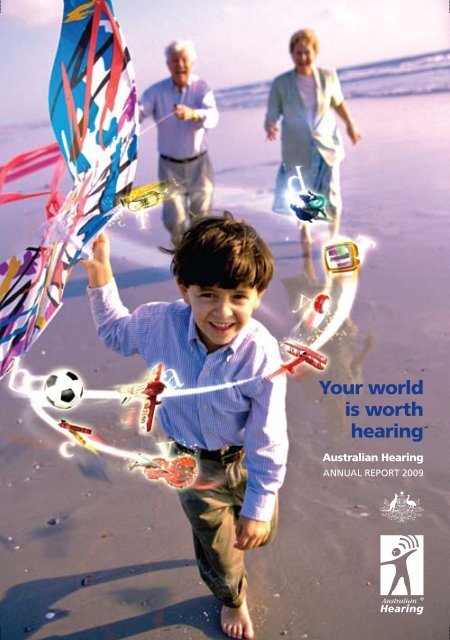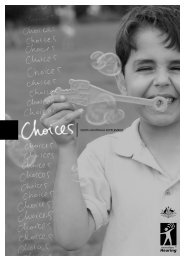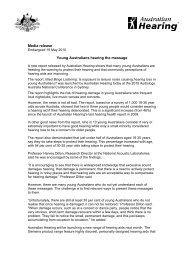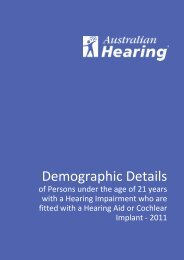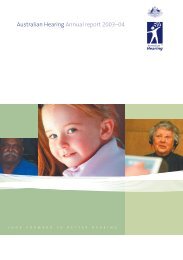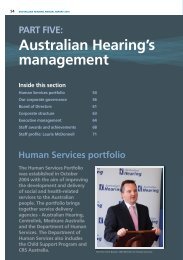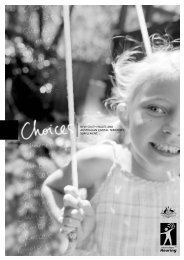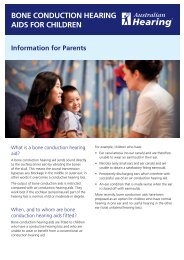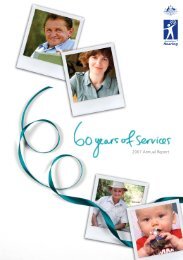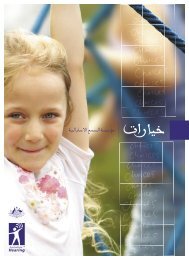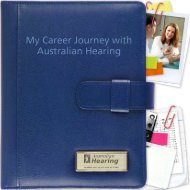Part One - Australian Hearing
Part One - Australian Hearing
Part One - Australian Hearing
Create successful ePaper yourself
Turn your PDF publications into a flip-book with our unique Google optimized e-Paper software.
Your world<br />
is worth<br />
hearing<br />
<strong>Australian</strong> <strong>Hearing</strong><br />
Annual Report 2009
i<br />
Letter to the Minister<br />
The Hon Chris Bowen MP<br />
Minister for Human Services<br />
Minister for Financial Services,<br />
Superannuation and Corporate Law<br />
Parliament House<br />
Canberra ACT 2600<br />
Dear Minister<br />
I have pleasure in presenting <strong>Australian</strong> <strong>Hearing</strong>’s Annual<br />
Report for the financial year 2008/09. The report has been<br />
prepared in accordance with the requirements of the <strong>Australian</strong><br />
<strong>Hearing</strong> Services Act 1991, the Commonwealth Authorities and<br />
Companies Act 1997 and relevant Finance Minister’s orders.<br />
The report outlines the achievements and milestones met<br />
by <strong>Australian</strong> <strong>Hearing</strong> in 2008/09. Following a resolution<br />
of the Board, the Directors’ Report of operations<br />
for the year ended 30 June 2009 is included.<br />
Yours sincerely<br />
Kathryn Greiner AO<br />
Chairman<br />
25 September 2009
ii <strong>Australian</strong> <strong>Hearing</strong> Annual report 2009<br />
Contents<br />
<strong>Part</strong> one:<br />
Overview.................................................................iii<br />
<strong>Australian</strong> <strong>Hearing</strong> highlights..................... iii<br />
Corporate profile<br />
who are we?..................................................................2<br />
<strong>Hearing</strong> loss in Australia<br />
It’s more common than you think...........................4<br />
Telscreen TM<br />
our unique, over-the-telephone hearing test........6<br />
Message from the Chairman.........................7<br />
Managing Director’s report.........................10<br />
Year in review......................................................13<br />
Financial highlights..........................................16<br />
Financial summary............................................17<br />
Support for the future....................................18<br />
<strong>Part</strong> Two:<br />
<strong>Australian</strong> <strong>Hearing</strong> in<br />
the community................................................. 19<br />
Client profile:<br />
Danielle Richardson..........................................21<br />
Our Community Service<br />
Obligation program.........................................22<br />
Client profile:<br />
May Howard.........................................................25<br />
case study:<br />
Visiting Docker River.......................................27<br />
Indigenous Services<br />
working together....................................................28<br />
Client profile:<br />
Arthur Heywood................................................31<br />
Voucher services<br />
keeping our clients connected..............................32<br />
Multicultural Services<br />
recognising cultural diversity..............................34<br />
<strong>Australian</strong> <strong>Hearing</strong> network.......................36<br />
Case study:<br />
The Black Saturday Victorian<br />
bushfires response............................................38<br />
<strong>Part</strong> Three:<br />
National Acoustic Laboratories....... 39<br />
<strong>Part</strong> Four:<br />
<strong>Australian</strong> <strong>Hearing</strong>’s<br />
management...................................................... 42<br />
People and Performance...............................42<br />
Case study:<br />
The Voucher Clinical<br />
Assistant program.............................................46<br />
Information Technology<br />
connecting our people............................................47<br />
Case study:<br />
From the city to the outback......................48<br />
Corporate Services<br />
What we’re doing for the environment...............49<br />
Marketing and Communication<br />
Communicating and connecting<br />
with the community.................................................51<br />
<strong>Part</strong> Five:<br />
About <strong>Australian</strong> <strong>Hearing</strong>..................... 53<br />
Human Services Portfolio.............................53<br />
Our corporate governance ..........................55<br />
Board of Directors.............................................60<br />
Directors’ Report................................................61<br />
Board of Directors’ biographies................61<br />
Executive staff members...............................63<br />
Australia Day achievement awards........67<br />
Staff profile:<br />
Terry Clayton........................................................69<br />
Statement of Commitment<br />
to Reconciliation.................................................70<br />
<strong>Part</strong> six:<br />
Finance.................................................................... 71<br />
Independent Audit Report...........................72<br />
Statement by the Directors.........................73<br />
Financial Statements.......................................74<br />
Appendices............................................................94<br />
Glossary................................................................ 100<br />
Compliance index........................................... 102<br />
Index....................................................................... 103<br />
List of <strong>Australian</strong> <strong>Hearing</strong> centres........ 104
iii <strong>Australian</strong> <strong>Hearing</strong> Annual report 2009<br />
<strong>Part</strong> one:<br />
Overview<br />
<strong>Australian</strong> <strong>Hearing</strong> highlights<br />
• We increased the number of<br />
Indigenous children seen by<br />
nine per cent and the number<br />
of Indigenous adults by 10 per<br />
cent compared with 2007/08. See<br />
page 28 for more on Indigenous services.<br />
• We launched the Telscreen TM<br />
telephone hearing service, which<br />
provides a free over-the-phone<br />
hearing check, in Cantonese and<br />
Mandarin languages on 20 March<br />
2009. Since its launch, 2,131<br />
calls have been made to the<br />
Cantonese or Mandarin service,<br />
which attracted widespread<br />
coverage in the Chinese media.<br />
See page six for more on Telscreen TM .<br />
• Community Service Obligation<br />
(CSO) client numbers grew<br />
by nine per cent and we<br />
fitted seven per cent more<br />
hearing aids to CSO clients.<br />
• We provided 100,206<br />
CSO services. This was an<br />
increase of four per cent on<br />
the previous year. See page<br />
22 for more on our CSO services.<br />
• We opened 11 new permanent<br />
hearing centres, bringing the<br />
total number of centres to 106.<br />
See page 49 for more on our property.<br />
• We achieved quality certification<br />
to the standard AS/NZS ISO<br />
9001:2008 in March 2009.<br />
See page 50 for more on quality.<br />
Our mission<br />
<strong>Australian</strong> <strong>Hearing</strong> provides the best<br />
hearing care, the latest hearing aid<br />
technology, and leads the world in<br />
hearing research.
<strong>Part</strong> one: overview<br />
1<br />
We introduced five new Siemens<br />
devices throughout the year, including<br />
the Motion, Explorer, Life, Vibe and<br />
Pure products, together with the launch<br />
of the Bluetooth TEK remote<br />
control and the gigaset telephone.<br />
• Our research division, the<br />
National Acoustic Laboratories<br />
(NAL) launched new research,<br />
the Listening in Spatialized<br />
Noise – Sentences (LiSN-S) test<br />
to medical professionals at<br />
the Libby Harricks Memorial<br />
Oration with keynote speaker,<br />
Professor Graeme Clark AC.<br />
• NAL completed recruitment<br />
to the Child Outcomes study;<br />
the outcomes of 475 children<br />
will now be followed until<br />
they reach eight years of<br />
age. See page 39 for more on NAL.<br />
• We performed well this year<br />
given the current economic<br />
conditions. Our percentage<br />
earnings before interest, tax,<br />
depreciation and amortisation<br />
(EBITDA) was more than 10 per<br />
cent. See pages 16–17 for more on finance.<br />
• We increased the number of<br />
culturally and linguistically<br />
diverse (CALD) clients by<br />
3.3 per cent, exceeding our<br />
target of two per cent. See page<br />
34 for more on our CALD program.<br />
• We introduced a virtual human<br />
resources (HR) office for<br />
employees which is accessed<br />
via the intranet. Called MyHR,<br />
the system allows employees to<br />
perform functions traditionally<br />
administered via HR or payroll. See<br />
page 42 for more on people and performance.<br />
Our values<br />
Care for our clients,<br />
stakeholders and ourselves.<br />
Integrity in all we do.<br />
Innovation in our clinical<br />
field and our business.<br />
Team performance<br />
supporting and encouraging<br />
winning teams.<br />
Respect for all people in<br />
all we do.
2 <strong>Australian</strong> <strong>Hearing</strong> Annual report 2009<br />
Corporate profile<br />
who are we?<br />
We are the nation’s largest provider of hearing services.<br />
We were established by the <strong>Australian</strong> Government in<br />
1947 to provide hearing services to children whose hearing<br />
was affected by a series of rubella epidemics and to assist<br />
veterans who suffered hearing damage during World War II.<br />
<strong>Australian</strong> <strong>Hearing</strong> is a statutory<br />
authority constituted under<br />
the <strong>Australian</strong> <strong>Hearing</strong> Services<br />
Act 1991, reporting to the<br />
Minister for Human Services, and<br />
Minister for Financial Services,<br />
Superannuation and Corporate<br />
Law, the Hon Chris Bowen MP.<br />
We focus on two key areas:<br />
• providing hearing<br />
health services through<br />
a national network of<br />
hearing centres; and<br />
• undertaking research through<br />
the National Acoustic<br />
Laboratories (NAL).<br />
Our programs<br />
We provide hearing services<br />
under the <strong>Australian</strong> Government<br />
<strong>Hearing</strong> Services Program, which<br />
is administered by the Department<br />
of Health and Ageing through<br />
the Office of <strong>Hearing</strong> Services<br />
(OHS). The <strong>Hearing</strong> Services<br />
Program has two streams – the<br />
Community Service Obligation<br />
(CSO) program and the Voucher<br />
program. We are the sole<br />
provider of services to children<br />
under 21, Indigenous adults<br />
over 50 and adults with complex<br />
hearing needs, through the CSO<br />
program. We also compete with<br />
207 private service providers<br />
for Voucher program clients.<br />
Our services<br />
Our services include assessing<br />
hearing, fitting hearing devices<br />
and providing counselling and<br />
rehabilitative programs to enable<br />
eligible clients to manage their<br />
hearing impairment. Many of<br />
our audiologists are specialists<br />
in particular fields of service<br />
delivery. These include paediatric,<br />
adults with complex rehabilitation<br />
needs and outreach services to<br />
Aboriginal and Torres Strait Islander<br />
clients under the <strong>Australian</strong><br />
<strong>Hearing</strong> Specialist Program for<br />
Indigenous <strong>Australian</strong>s (AHSPIA).<br />
CSO funding also supports NAL.<br />
NAL performs research in hearing<br />
habilitation and rehabilitation and<br />
the prevention of hearing loss.<br />
NAL is also a core party in the<br />
<strong>Hearing</strong> Cooperative Research<br />
Centre (<strong>Hearing</strong> CRC) which<br />
commenced in July 2007.<br />
The following table shows the number of audiological services, which includes hearing assessment,<br />
device fitting and rehabilitation services, provided over the five-year period from 2005 to 2009.<br />
Table <strong>One</strong>: Audiological services provided 2005–2009<br />
(Includes Voucher and CSO clients)<br />
2005 2006 2007 2008 2009<br />
Children 47,315 48,318 49,522 56,130 56,358<br />
Adult clients 296,931 313,747 316,573 327,367 342,494<br />
Total 344,246 362,065 366,095 383,497 398,852
<strong>Part</strong> <strong>One</strong>: Overview<br />
3<br />
Graph <strong>One</strong>: age distribution of active clients<br />
20%<br />
15%<br />
10%<br />
5%<br />
0%<br />
AGED<br />
0–9<br />
AGED<br />
10–19<br />
AGED<br />
20–29<br />
AGED<br />
30–39<br />
AGED<br />
40–49<br />
AGED<br />
50–59<br />
AGED<br />
60–69<br />
AGED<br />
70–79<br />
AGED<br />
80–89<br />
AGED<br />
90–99<br />
AGED<br />
100–109<br />
AGED<br />
110–119<br />
Our clients<br />
Our clients are comprised of<br />
children and young adults under<br />
the age of 21, veterans, Indigenous<br />
adults over 50 and aged<br />
pensioners. To be able to receive<br />
hearing health services under<br />
the CSO or Voucher programs,<br />
clients must meet specific eligibility<br />
criteria. Aged pensioners and<br />
veterans are our largest client<br />
groups and access services through<br />
the Voucher program. See Appendix<br />
2 for specific eligibility criteria.<br />
Our workforce<br />
As at 30 June 2009, <strong>Australian</strong><br />
<strong>Hearing</strong> employed 1,115 people<br />
nationally in a network of 106<br />
hearing centres and a corporate<br />
head office located in Sydney. Key<br />
roles within the network of hearing<br />
centres include clinical, technical,<br />
customer service and management<br />
positions. New Business Assistant<br />
and Clinical Assistant positions<br />
were created this year to support<br />
the network restructure which<br />
took effect 1 July 2008. See<br />
page 42 for more on our people.<br />
Head office functions provide<br />
support to the network operations<br />
and include Corporate Services,<br />
Marketing and Communication,<br />
Indigenous and Multicultural Services,<br />
Information Technology, Finance<br />
and People and Performance. NAL<br />
research and administrative staff<br />
are also based at head office.<br />
Our reach across Australia<br />
As at 30 June 2009, our network<br />
consisted of 106 hearing centres,<br />
including one specialised paediatric<br />
hearing centre and 298 visiting and<br />
remote sites (which provide services<br />
on a regular scheduled basis)<br />
located across Australia. We also<br />
delivered hearing services at 238<br />
Indigenous outreach sites in urban,<br />
rural and remote areas of Australia.<br />
See page 36 for more on our network.<br />
figure <strong>One</strong>: gender<br />
distribution of<br />
active clients<br />
53%<br />
MALE<br />
47%<br />
FEMALE
4 <strong>Australian</strong> <strong>Hearing</strong> Annual report 2009<br />
<strong>Hearing</strong> loss in<br />
Australia<br />
It’s more common than you think<br />
<strong>One</strong> in six people in Australia has<br />
a hearing loss. With the ageing of<br />
the <strong>Australian</strong> population, hearing<br />
loss is projected to increase to one<br />
in every four <strong>Australian</strong>s by 2050. 1<br />
Causes of hearing loss<br />
The most significant single cause of<br />
hearing loss in Australia is exposure<br />
to loud noise. Thirty-seven per cent<br />
of hearing loss is due to excessive<br />
noise exposure. 1 However, hearing<br />
loss can also occur through illness,<br />
accident, exposure to certain<br />
drugs and chemicals, and as part<br />
of the normal ageing process.<br />
<strong>Hearing</strong> loss<br />
among children<br />
In Australia, between nine and<br />
12 children per 10,000 live births<br />
will be born with a moderate or<br />
greater hearing loss in both ears.<br />
About a further 23 children per<br />
10,000 will acquire a hearing<br />
impairment that requires hearing<br />
aids by the age of 17 through<br />
accident, illness or other causes. 1<br />
Otitis media (middle ear infection)<br />
is often associated with temporary<br />
or fluctuating hearing loss.<br />
This in turn can affect a child’s<br />
learning, language development<br />
and behaviour. The incidence of<br />
otitis media is significantly higher<br />
among Indigenous children, for<br />
whom it represents a serious<br />
health and educational issue.<br />
<strong>Hearing</strong> loss among<br />
seniors and veterans<br />
More than half the population<br />
aged between 60 and 70 has a<br />
hearing loss. 2 This increases to<br />
more than 70 per cent of those<br />
70 years and older 2 and 80 per<br />
cent of those over the age of 80. 3<br />
Men have a higher incidence<br />
of hearing loss than women, 3<br />
mainly due to noise exposure in<br />
the workplace and during war<br />
service. <strong>Hearing</strong> loss is the second<br />
most common medical condition<br />
reported by both <strong>Australian</strong> war<br />
veterans and war widows.<br />
Attitudes to hearing<br />
and hearing loss<br />
Our 2008 report, Is Australia Listening? Attitudes to hearing loss,<br />
researched the perceptions and behaviours of 1,000 <strong>Australian</strong><br />
adults regarding hearing health. The report found that:<br />
• one quarter of young <strong>Australian</strong>s (18–34 years) don’t realise<br />
that once your hearing is damaged, it cannot be restored;<br />
• nearly half of 18–34 year old <strong>Australian</strong>s go to noisy bars and pubs<br />
and listen to music through headphones at least once a week;<br />
• sixty per cent of all <strong>Australian</strong>s reported they had suffered from<br />
noticeable tinnitus (also known as ringing in the ears and a sign of<br />
hearing damage) with prevalence higher among young <strong>Australian</strong>s;
<strong>Part</strong> <strong>One</strong>: Overview<br />
5<br />
<strong>Hearing</strong> loss and<br />
depression<br />
We released results of a survey in<br />
2007, which found that people<br />
suffering hearing loss may be<br />
at increased risk of developing<br />
the debilitating effects of<br />
depression. 4 The survey found<br />
that 60 per cent of those with<br />
hearing loss had displayed some<br />
of the symptoms associated<br />
with depression. It also found<br />
that almost 20 per cent of those<br />
with hearing loss demonstrated<br />
at least three key symptoms<br />
of depression. 5 Specifically:<br />
• fifty-two per cent displayed<br />
increased irritability<br />
and frustration;<br />
• twenty-two per cent<br />
had trouble sleeping or<br />
experienced restlessness; and<br />
• eighteen per cent showed a<br />
loss of interest or pleasure<br />
in most activities.<br />
The cost to the economy<br />
<strong>Hearing</strong> loss costs Australia<br />
almost $12 billion a year.<br />
Almost 160,000 people do not<br />
work because they can not<br />
hear well enough. 1 In addition,<br />
compensation claims for noise<br />
induced hearing loss comprise a<br />
significant proportion of all claims<br />
for occupational diseases. 1<br />
<strong>Hearing</strong> health solutions<br />
An expertly fitted digital hearing<br />
aid can significantly reduce<br />
the physical and emotional<br />
consequences of hearing loss.<br />
People who wear hearing aids are<br />
less affected by depression, have<br />
improved health, and experience<br />
a better sense of independence<br />
and control over their lives. 6<br />
1 Access Economics: Listen Hear! The<br />
economic impact and cost of hearing loss<br />
in Australia, February 2006. 2 Wilson D,<br />
Walsh PG, Sanchez L and Read P: <strong>Hearing</strong><br />
Impairment in an <strong>Australian</strong> Population,<br />
Centre for Population Studies in<br />
Epidemiology, South <strong>Australian</strong> Department<br />
of Human Services, 1998. Statistics based<br />
on a 4 frequency average hearing loss<br />
greater than 25dB HL in the worse ear.<br />
3 Mitchell P et al: The Prevalence, Risk<br />
Factors and Impacts of <strong>Hearing</strong> Impairment<br />
in an Older <strong>Australian</strong> Community: the<br />
Blue Mountains <strong>Hearing</strong> Study, 2002.<br />
4 This Newspoll survey was conducted in<br />
July – August 2007 by telephone among<br />
2,401 adults aged 18+ nationally, including<br />
n=305 who live with someone with<br />
hearing loss. 5 Reported by those who<br />
live with someone with hearing loss.<br />
6 National Council of Ageing: The Impact<br />
of Untreated <strong>Hearing</strong> Loss in Older<br />
Americans, December 1998.<br />
• although 41 per cent of people believed their own hearing<br />
was ‘very good’ or ‘almost perfect’, four in five <strong>Australian</strong>s<br />
reported to know someone with a hearing loss; and<br />
• despite most <strong>Australian</strong>s thinking loud noise was the major cause<br />
of hearing loss, more than two thirds of <strong>Australian</strong>s listen to music<br />
through headphones regularly. Twelve per cent of headphone users<br />
regularly listen at unsafe levels while 48 per cent sometimes do.
6 <strong>Australian</strong> <strong>Hearing</strong> Annual report 2009<br />
Telscreen TM<br />
our unique, over-thetelephone<br />
hearing test<br />
The concept of a telephone<br />
hearing test – being able to<br />
call a number and check your<br />
hearing over the telephone<br />
– was first introduced in<br />
2007. We commissioned our<br />
research division, NAL, to<br />
develop a test that would<br />
be suitable for use in Australia.<br />
April Chong, Audiologist, <strong>Australian</strong><br />
<strong>Hearing</strong> Box Hill with Dan Zhou,<br />
Researcher, NAL.<br />
The science behind the test<br />
Professor Harvey Dillon, Research<br />
Director, and NAL developed<br />
Telscreen TM by improving on a<br />
similar telephone hearing check<br />
invented in The Netherlands.<br />
Telscreen TM enables callers to check<br />
their hearing over-the-telephone<br />
in about five minutes. It works<br />
by asking the caller to respond<br />
on their keypad when they can<br />
hear a sound which is played over<br />
the top of background noise.<br />
A computer controls the test and<br />
gradually reduces or increases<br />
the loudness of the digits. The<br />
background noise has gaps in<br />
time and frequency, which greatly<br />
obscures speech for people with<br />
a hearing loss but has a structure<br />
that people with normal hearing<br />
can more easily ‘hear through’.<br />
Based on the caller’s responses, the<br />
computer calculates the level of<br />
the speech, relative to the noise,<br />
at which the caller can just hear.<br />
The test result is compared to<br />
results obtained by people with<br />
normal hearing and the caller<br />
is advised whether his or her<br />
ability to hear in noise is within,<br />
or is outside, the range found for<br />
people with normal hearing.<br />
The test continues<br />
to develop<br />
We launched the first version of<br />
Telscreen TM in September 2007.<br />
More than 55,000 calls were<br />
received in the first two months<br />
of operation. A second, more<br />
sophisticated, version was then<br />
released in January 2008.<br />
This year, to make the test<br />
available to people who speak<br />
other languages, Professor Dillon<br />
and his team developed the latest<br />
version of Telscreen TM , replacing<br />
digits read out in background<br />
noise with ‘tone pips’.<br />
The use of tone pips instead<br />
of digits means that the test<br />
doesn’t rely on knowledge of<br />
any language. Callers simply<br />
respond to the sound of a beep.<br />
This means we can adapt the test<br />
to any language group just by<br />
changing the spoken commentary.<br />
Reaching new audiences<br />
We chose one of the largest<br />
non-English language groups<br />
in Australia – Cantonese and<br />
Mandarin – to launch the<br />
third version of the test.<br />
To do this, we held a media<br />
conference in Sydney’s Chinatown<br />
on 20 March 2009. The response<br />
from Chinese media was excellent,<br />
with more than 12 newspapers,<br />
three radio stations and two TV<br />
stations covering the story.<br />
More than 2,000 calls were<br />
received in the 11 days following<br />
the conference; 65 per cent of<br />
these to the Chinese language<br />
versions. The launch also enabled<br />
us to strengthen our relationships<br />
with key stakeholders from<br />
the Chinese community.<br />
A total of 44,823 completed<br />
calls have been made to<br />
Telscreen TM during 2008/09, of<br />
which 2,131 have been to the<br />
Chinese languages version since<br />
its launch in March 2009.<br />
What next for Telscreen TM ?<br />
Telscreen TM was – and still is – the<br />
most sophisticated telephone<br />
hearing test in the world. The<br />
test helps people take the first<br />
step towards managing a hearing<br />
loss and is a great tool for raising<br />
public awareness of hearing loss.<br />
Plans are underway to<br />
roll out the test in further<br />
languages in 2009/10.
<strong>Part</strong> <strong>One</strong>: Overview<br />
7<br />
Message<br />
from the<br />
Chairman<br />
Having said farewell<br />
to our previous<br />
Managing Director,<br />
Ms Anthea Green,<br />
in October 2008,<br />
the Board and I<br />
were pleased to<br />
welcome Mr Steven<br />
Grundy to the role of<br />
Managing Director.<br />
In the prior year,<br />
Steven undertook<br />
the role of Chief<br />
Operating Officer.
8 <strong>Australian</strong> <strong>Hearing</strong> Annual report 2009<br />
Message from the Chairman (continued)<br />
Previously the General Manager for<br />
management of Telstra Payphones,<br />
Steven brings strong management<br />
skills to <strong>Australian</strong> <strong>Hearing</strong>. In his<br />
eight months as Managing Director,<br />
Steven has built on the organisation’s<br />
strong foundations and has been<br />
an excellent stabilising influence in<br />
this tough economic environment.<br />
Strong financial<br />
performance<br />
In 2008/09, we reported a profit<br />
before tax of $11.5 million, which<br />
was slightly above the budgeted<br />
target of $11.3 million. <strong>Australian</strong><br />
<strong>Hearing</strong> paid dividends during the<br />
year to the <strong>Australian</strong> Government<br />
through the Department of<br />
Human Services of $4.6 million<br />
against a budget of $4.7 million.<br />
Earnings before interest, tax,<br />
depreciation and amortisation<br />
(EBITDA), as a percentage of<br />
revenue, remained solid at<br />
10.2 per cent compared to<br />
the budget of 10.7 per cent<br />
and last year of 12.0 per cent.<br />
Importantly, the profit before tax<br />
as a percentage of total revenue<br />
was seven per cent compared<br />
to a budget of six per cent.<br />
<strong>Australian</strong> <strong>Hearing</strong> focused on<br />
cost savings and careful financial<br />
management and we are delighted<br />
with our financial result for<br />
the year. More importantly, we<br />
continued our quality service to our<br />
clients and reached out to assist<br />
many more in our communities.<br />
New Minister for<br />
Human Services<br />
This year I worked closely with<br />
the former Minister for Human<br />
Services, Senator the Hon Joe<br />
Ludwig. Senator Ludwig attended<br />
many official openings of our<br />
new centres and supported<br />
both <strong>Hearing</strong> Awareness Week<br />
and our Telscreen TM launches.<br />
Following a Cabinet reshuffle,<br />
Senator Ludwig has now taken<br />
up the role of Cabinet Secretary<br />
and Special Minister of State.<br />
<strong>Australian</strong> <strong>Hearing</strong> thanks the<br />
Minister for his support of our<br />
work and we wish him well.<br />
We welcomed the Hon Chris<br />
Bowen MP, who manages<br />
the portfolios of Human<br />
Services, and Financial Services,<br />
Superannuation and Corporate<br />
Law. I met with the Minister<br />
soon after his appointment and<br />
had the pleasure of escorting<br />
him during his visit to National<br />
Head Office in July this year. The<br />
Minister is conscious of hearing<br />
impairment and its effects and<br />
is working with us on improving<br />
the lives and opportunities<br />
of the hearing impaired.<br />
<strong>Australian</strong> <strong>Hearing</strong><br />
Board and Committees<br />
<strong>Australian</strong> <strong>Hearing</strong> currently leases<br />
its head office premises at West<br />
Chatswood (NSW). The lease<br />
expires in 2013. To plan for a<br />
potential relocation, we established<br />
a Relocation Committee which<br />
includes Mr Warren Stretton<br />
and me as members of the<br />
Board, along with Mr Stephen<br />
Patterson, Chief Operating<br />
Officer and Mr Steven Grundy to<br />
oversee the negotiations for the<br />
relocation of our head office.<br />
In line with our environmental<br />
values, Board members are now<br />
able to access Board reports<br />
online as we trial paperless Board<br />
meetings. We hope this initiative<br />
encourages our staff to continue to<br />
reduce their paper use. See page 49<br />
for more on our environmental initiatives.<br />
Other Committees of the<br />
Board include the Audit and<br />
Risk Management Committee,<br />
chaired by Mr Warren Stretton;<br />
and the Research Committee,<br />
which I chair. I would like to<br />
thank all our Directors for their<br />
interest, diligence and accessibility<br />
throughout the year. It has been<br />
a real team effort. See page 55 for<br />
more on our corporate governance.<br />
<strong>Hearing</strong> services for<br />
Indigenous <strong>Australian</strong>s<br />
It is pleasing to report that<br />
we maintained our extensive<br />
Indigenous outreach program,<br />
providing services at 238 locations.<br />
Many service providers are working<br />
together to improve hearing health<br />
inequality. This includes primary,<br />
secondary and tertiary health<br />
services; medical, educational<br />
and audiological; mainstream and<br />
community-controlled services.<br />
<strong>Australian</strong> <strong>Hearing</strong> has always been<br />
a leader in providing services to
<strong>Part</strong> <strong>One</strong>: Overview<br />
9<br />
Indigenous <strong>Australian</strong>s, whether in<br />
urban, rural or remote locations.<br />
The Indigenous community assists<br />
us in being able to provide these<br />
services throughout Australia. By<br />
working together, we can reduce<br />
hearing loss in children and adults.<br />
Equitable access<br />
to services<br />
I had great pleasure attending a<br />
variety of events throughout the<br />
year aimed at increasing access<br />
to services for our culturally and<br />
linguistically diverse (CALD) clients.<br />
A highlight of the year was the<br />
launch of our Telscreen TM telephone<br />
hearing test to Cantonese and<br />
Mandarin speaking <strong>Australian</strong>s.<br />
See page six for more on Telscreen TM .<br />
Included in these activities were<br />
CALD morning teas held in Sydney,<br />
Brisbane and Melbourne. These<br />
were an opportunity for our<br />
staff to meet key stakeholders<br />
and learn about how we can<br />
best interact with, and improve<br />
our service provision to, CALD<br />
communities. Our website has<br />
been improved to make it easier<br />
for our CALD web users to access<br />
information in the language of<br />
their origin. See page 34 for further<br />
information on our CALD program.<br />
Building strong<br />
relationships with<br />
hearing aid providers<br />
While on a private trip to<br />
Germany in May 2009, I accepted<br />
an invitation to visit Siemens’<br />
headquarters in Erlangen.<br />
Siemens is our major provider of<br />
hearing instruments and I was<br />
delighted to meet with their<br />
senior executives. I shared with<br />
them the challenges of providing<br />
services to our most remote clients<br />
and discussion was fruitful in the<br />
areas of marketing, paediatric<br />
services and developing technology<br />
in the next five to 10 years.<br />
Bushfire emergency<br />
response<br />
The Board was greatly impressed<br />
with the speed with which<br />
the organisation reacted to<br />
the Victorian ‘Black Saturday’<br />
bushfires in February 2009.<br />
Our staff provided services at<br />
Whittlesea, Kinglake and Diamond<br />
Creek outreach sites, as well as<br />
seeing clients at our Reservoir,<br />
Broadmeadows, Box Hill, Croydon,<br />
Morwell, Shepparton, Bendigo,<br />
Eltham, Lilydale and Horsham<br />
centres and visiting sites. Many<br />
staff at these centres reported<br />
feeling humbled by the experience.<br />
This is a great testament to our<br />
staff’s values of caring for people.<br />
The whole organisation supported<br />
their efforts with fundraising<br />
activities and I, along with Mr<br />
Steven Grundy and Mr Stephen<br />
Patterson, was pleased to present<br />
a cheque for $6,831 to the Red<br />
Cross in Sydney. See page 38 for<br />
the Victorian bushfire case study.<br />
Congratulations to staff<br />
This year, we were awarded Silver<br />
at the Australasian Reporting<br />
Awards held in Melbourne for<br />
our 2007/08 Annual Report. I was<br />
delighted to accept the award on<br />
behalf of the organisation and<br />
congratulate the team on this<br />
second consecutive Silver Award.<br />
I would also like to congratulate<br />
our Australia Day achievement<br />
award winners who continue to<br />
meet exceptional standards of<br />
service. This is an internal award<br />
which has been run for more<br />
than 10 years and continues<br />
to acknowledge outstanding<br />
efforts from staff who embody<br />
our core values. For more on<br />
the award winners see page 67.<br />
Looking ahead<br />
In the two years I have had the<br />
privilege of being Chairman of<br />
<strong>Australian</strong> <strong>Hearing</strong>, I have noted<br />
the commitment and passion<br />
of the entire team to provide<br />
high quality hearing services.<br />
We have continued to increase<br />
our reach while maintaining our<br />
high quality services, both in<br />
the CSO and Voucher areas.<br />
Our focus in 2009/10 will be to<br />
maintain our strong business<br />
in a challenging economic<br />
environment while continuing to<br />
provide our world class service<br />
to the hearing impaired.<br />
Kathryn Greiner AO<br />
Chairman
10 <strong>Australian</strong> <strong>Hearing</strong> Annual report 2009<br />
Managing<br />
Director’s report<br />
I was pleased to take over as<br />
Managing Director of <strong>Australian</strong><br />
<strong>Hearing</strong> in October 2008. It is<br />
an organisation with a long<br />
history and during my time<br />
as Managing Director, I will<br />
be working to maintain our<br />
position as the leading provider<br />
of hearing services in Australia.
<strong>Part</strong> <strong>One</strong>: Overview<br />
11<br />
I am proud of the achievements of<br />
the network and head office staff in<br />
continuing to deliver on our Corporate<br />
Plan goals while adapting to a new<br />
structure and a new Managing Director.<br />
The organisation has performed<br />
well during the year and I am<br />
pleased to report that we have<br />
met our profit target for 2008/09.<br />
Delivering this result was a<br />
significant achievement given<br />
the global financial crisis and<br />
changes to OHS processes. Our<br />
staff have shown great resilience<br />
and have taken these challenging<br />
times in their stride. I would like<br />
to take this opportunity to thank<br />
the <strong>Australian</strong> <strong>Hearing</strong> team for<br />
their hard work during the year.<br />
Initiatives to ensure strong<br />
financial performance<br />
This year I introduced a number of<br />
measures to strengthen our ability<br />
to respond to market fluctuations.<br />
I established a cost savings group<br />
to review areas of the organisation<br />
where savings could be achieved<br />
without impacting on staff or client<br />
services, along with a revenue<br />
initiatives group which examined<br />
alternative revenue streams. These<br />
groups have representation from all<br />
areas of the organisation and staff<br />
have the opportunity to participate<br />
on a rotating six-monthly basis.<br />
I have been impressed with the<br />
range of great ideas these groups<br />
have already generated, many of<br />
which have been implemented to<br />
the benefit of the organisation.<br />
Solid operating<br />
performance<br />
<strong>Australian</strong> <strong>Hearing</strong> operates in<br />
a highly competitive market<br />
with 207 other hearing service<br />
providers. During the year, total<br />
revenue was impacted by factors<br />
beyond our control; however,<br />
profitability remained stable<br />
despite increases in salary costs and<br />
real estate expenditure. Although<br />
we did not meet our revenue<br />
target this year, I’m pleased that<br />
we did meet our profit target.<br />
This was due to the hard work and<br />
dedication of all staff. See pages 16–17<br />
for more on our financial performance.<br />
New network structure<br />
Our network of hearing centres is<br />
the face of our organisation and<br />
both our centres and head office<br />
have delivered exceptional service<br />
and results in challenging times.<br />
During the year, we restructured<br />
the organisation from nine<br />
regions to six, with an emphasis<br />
on increased leadership and<br />
management responsibilities.<br />
This change has strengthened<br />
our ability to react quickly and<br />
effectively to market changes and<br />
conditions. To support the new<br />
structure, we created new clinical<br />
and administrative positions which<br />
have enhanced our clinical service<br />
delivery and provided our staff with<br />
more career pathways. The focus in<br />
2009/10 is to build on this strong<br />
framework to ensure continued<br />
service excellence and profitability.<br />
Taking our service to<br />
the community<br />
This year we purchased a fully<br />
equipped bus to provide mobile<br />
hearing screenings in regional and<br />
urban areas. The bus has provided<br />
the opportunity for us to take<br />
our services to the community<br />
and improve access to services<br />
for clients in rural locations. We<br />
have also taken the bus to two<br />
Indigenous events and visited<br />
seven Indigenous communities<br />
throughout the year. The bus<br />
has generated a lot of interest at<br />
these locations and we have been<br />
successful in providing services<br />
where gaps existed previously.<br />
The mobile service also enabled<br />
us to respond quickly to the<br />
Victorian bushfire emergency in<br />
February this year. Employees<br />
from our centres across Victoria<br />
volunteered to staff and drive the<br />
bus to affected areas to provide<br />
replacement hearing aids, batteries<br />
and support services to anyone<br />
requiring assistance. See page 38<br />
for the Victorian bushfire case study.<br />
We also expanded our telephone<br />
hearing service to include<br />
Cantonese and Mandarin<br />
languages. I was pleased to launch<br />
this third version of Telscreen TM<br />
in March 2009 to the Chinese<br />
community. Telscreen TM has been<br />
well received, with 44,823 calls<br />
to the service this year. We plan<br />
to expand this service into other<br />
languages in 2009/10. See page<br />
six for more on the Telscreen TM story.
12 <strong>Australian</strong> <strong>Hearing</strong> Annual report 2009<br />
Managing Director’s report (continued)<br />
Commitment to<br />
Community Service<br />
Obligation clients<br />
We have continued to undertake<br />
excellent work in our Community<br />
Service Obligation (CSO) program,<br />
providing high quality services to<br />
our CSO clients with the <strong>Australian</strong><br />
Government funding we received.<br />
In 2008/09, we increased the<br />
number of services provided to<br />
children under 21, adults with<br />
complex hearing needs and<br />
eligible Indigenous clients, and<br />
continued to provide culturally<br />
appropriate services through our<br />
Indigenous outreach program.<br />
We also evaluated our service<br />
delivery through client surveys,<br />
with results indicating high levels<br />
of satisfaction with both service<br />
and devices provided. See page<br />
22 for more on our CSO program.<br />
National Acoustic<br />
Laboratories<br />
Our research division, the National<br />
Acoustic Laboratories (NAL),<br />
continued its research in the areas<br />
of auditory processing disorders,<br />
finalised recruitment to the Child<br />
Outcomes study (which measures<br />
the ability of children to produce<br />
speech, understand speech and<br />
acquire language) and developed<br />
a new formula for prescribing<br />
hearing aids. NAL also conducted<br />
research on the impact of leisure<br />
noise and noise in the workplace,<br />
and developed an improved version<br />
of Telscreen TM . We work closely<br />
with NAL to ensure our hearing<br />
solutions are founded on quality<br />
research. See page 39 for more on NAL.<br />
Growth of centres<br />
and service outlets<br />
In 2008/09 there was a strong<br />
focus on expanding our network of<br />
sites and improving client access.<br />
During the year, we increased our<br />
number of new permanent centres<br />
by 11, opened 34 new visiting<br />
sites, increased the number of<br />
Indigenous Outreach sites by six<br />
and relocated three other centres.<br />
In 2009/10 we will continue to<br />
establish more ground floor, shop<br />
front hearing centres in order to<br />
provide easier access for our clients.<br />
A new executive team<br />
I am pleased to announce that our<br />
previous Chief Financial Officer, Mr<br />
Stephen Patterson, was successful<br />
in obtaining the Chief Operating<br />
Officer role. With a new Executive<br />
Manager People and Performance,<br />
Mr Carel Bothma, and new Chief<br />
Financial Officer, Mr Mario Torresan,<br />
now on board, we have a strong<br />
and energised Executive team to<br />
provide leadership and support to<br />
ensure we achieve our Corporate<br />
Plan goals over the coming year.<br />
See page 42 for more on our people.<br />
We continued to offer staff greater<br />
opportunities for career and<br />
leadership development during<br />
2008/09 and I am pleased with<br />
the progress we have made in<br />
our graduate recruitment and<br />
staff development programs.<br />
Managing Director’s<br />
staff communication<br />
I implemented new internal<br />
communication channels for our<br />
staff this year to ensure that staff<br />
are kept up-to-date with news<br />
from across the organisation. This<br />
has included a regular fortnightly<br />
all staff e-newsletter, a review of<br />
our corporate charity of choice<br />
and sharing of information<br />
across hearing centres via our<br />
intranet, including online staff<br />
profiles and an events calendar.<br />
Achieving accreditation<br />
Our organisation achieved<br />
formal quality certification to the<br />
standard AS/NZS ISO 9001:2008<br />
in March this year. We have been<br />
recognised as a quality certified<br />
organisation, being the only<br />
major hearing organisation to<br />
have achieved this. See page 50 for<br />
more on our quality management.<br />
Future directions<br />
In the coming year we will focus<br />
on <strong>Australian</strong> <strong>Hearing</strong> adopting<br />
a more retail look and feel to<br />
meet the changing needs of<br />
our clients. While we have<br />
a commercial focus, we will<br />
continue our valuable clinical<br />
work in the CSO area. Our CSO<br />
work is critical and a significant<br />
part of our service delivery.<br />
We have set a realistic growth<br />
budget for 2009/10. Despite the<br />
financial crisis and increasing<br />
competitor activity, I aim to ensure<br />
that <strong>Australian</strong> <strong>Hearing</strong> remains<br />
a commercially viable entity,<br />
ready for the challenges ahead.<br />
I would also like to thank<br />
Ms Anthea Green, our previous<br />
Managing Director, for her<br />
enormous contribution to<br />
<strong>Australian</strong> <strong>Hearing</strong> over the past<br />
seven years. I feel privileged<br />
to have taken over a well<br />
run, robust organisation with<br />
competent and vibrant staff who<br />
are passionate about their work<br />
and about making a difference<br />
to the lives of our clients.<br />
Steven Grundy<br />
Managing Director
<strong>Part</strong> <strong>One</strong>: Overview<br />
13<br />
Year in review<br />
This year we focused on improving access to our<br />
network of hearing centres by increasing the number of<br />
permanent and visiting sites and providing easier access<br />
and more convenient locations for existing centres.<br />
We also improved access to rural<br />
and Indigenous communities by<br />
purchasing a bus to make our<br />
hearing services mobile. Back<br />
at the office, we improved our<br />
technology in order to provide<br />
remote hearing services.<br />
The Memorandum of Understanding<br />
(MOU) between <strong>Australian</strong> <strong>Hearing</strong><br />
and the Office of <strong>Hearing</strong> Services<br />
(OHS) for the Delivery of Services<br />
to CSO and Research Activities<br />
2008/09 to 2011/12 was signed in<br />
February 2009. This year, we have<br />
provided services to 2.2 per cent<br />
more children, provided five per cent<br />
more hours of service to adults with<br />
complex needs and provided 14.1<br />
per cent more services to Indigenous<br />
clients, under the Indigenous<br />
Eligibility initiative, than last year.<br />
Other highlights included our<br />
Chinese New Year campaign, the<br />
Chairman’s CALD morning teas, our<br />
response to the Victorian bushfires,<br />
our national fundraising events<br />
for the Cancer Council Australia<br />
and <strong>Australian</strong> Red Cross and our<br />
2008 Sun-Herald City2Surf team.<br />
The following table shows our<br />
performance in 2008/09 against<br />
our Corporate Plan goals and our<br />
future directions for 2009/10.<br />
Goal Target performance Achievements Directions in 2009/10<br />
Establish a new network<br />
structure and implement a<br />
new model of client care.<br />
New structure<br />
in place by<br />
30 June 2009.<br />
Implementation of<br />
new clinical service<br />
delivery models.<br />
Expand reach<br />
of services into<br />
Indigenous<br />
communities using<br />
new technology.<br />
Recruitment of all<br />
positions was completed<br />
by 1 March 2009.<br />
The Clinical Assistant<br />
model is now standard<br />
business practice.<br />
Remote service trials, to<br />
extend our reach into<br />
remote communities,<br />
have been conducted<br />
throughout 2008/09. This<br />
has incorporated the<br />
use of portable clinical<br />
equipment technology.<br />
Two pilot programs will<br />
be held in the first half<br />
of 2009/10 to explore<br />
the use of a Clinical<br />
Assistant with supporting<br />
CSO service delivery.<br />
The outcomes of the remote<br />
trial project will be reviewed<br />
to determine the potential<br />
for implementation into<br />
business as usual in 2009/10.<br />
Grow <strong>Australian</strong><br />
<strong>Hearing</strong>’s commercial<br />
footprint.<br />
Establish five new<br />
centres to expand<br />
our footprint and<br />
improve strategic<br />
locations.<br />
Increase the number<br />
of new visiting<br />
sites nationally<br />
by at least 36.<br />
Eleven new centres<br />
opened for business.<br />
A total of 34 new visiting<br />
sites were opened.<br />
Four new sites will open<br />
in NSW and Victoria and<br />
three centres will be<br />
relocated during the first<br />
half of the 2009/10 year.<br />
Additional visiting sites<br />
have been identified to<br />
open in early 2009/10.<br />
Ensure<br />
best<br />
business<br />
practice.<br />
Gain ISO-9001<br />
quality accreditation.<br />
Achieved ISO-9001 Quality<br />
Management System<br />
certification for head<br />
office and all centres.<br />
Deliver on our corporate<br />
social responsibilities.<br />
On track Work progressing Did not achieve target this year
14 <strong>Australian</strong> <strong>Hearing</strong> Annual report 2009<br />
Year in review (continued)<br />
Goal Target performance Achievements Directions in 2009/10<br />
Exceeded client target for<br />
children by nine per cent<br />
(28,710 children seen).<br />
Met target for<br />
adults with complex<br />
rehabilitation needs.<br />
Increased the number<br />
of current CSO adults<br />
by 12.3 per cent<br />
compared to last year.<br />
Added two new fully<br />
subsidised paediatric devices<br />
to our range in 2008/09:<br />
the Siemens Explorer<br />
and the Phonak Naida.<br />
Provided 269 speech<br />
processors during 2008/09.<br />
Expanded FM product<br />
range as a result of<br />
a tender process.<br />
Provide quality hearing services to CSO<br />
clients within funding allocation.<br />
Deliver services<br />
according to<br />
client targets set<br />
by the OHS.<br />
Provide a higher<br />
level of technology<br />
for CSO clients<br />
based on device<br />
target and funding.<br />
Deliver services according to<br />
client targets set by the OHS.<br />
Deliver services according<br />
to quality standards set<br />
in the Memorandum<br />
of Understanding.<br />
Perform research that leads to improved methods<br />
for assessing, preventing and treating hearing loss<br />
and improving hearing rehabilitation procedures.<br />
Publish 20 scientific<br />
articles.<br />
Investigate<br />
improved methods<br />
for assessing<br />
hearing loss.<br />
Maximise the<br />
amount of research<br />
performed and<br />
disseminated<br />
by leveraging<br />
the CSO funding<br />
with additional<br />
funding sources.<br />
Published 31<br />
scientific articles.<br />
Launched version three<br />
of Telscreen TM telephone<br />
hearing test in Cantonese<br />
and Mandarin in March 2009.<br />
Launched Listening<br />
in Spatialized Noise –<br />
Sentences (LiSN-S) test in<br />
May 2009 for detecting<br />
auditory processing disorder.<br />
Finalised recruitment to<br />
the Child Outcomes study.<br />
Received National Institute<br />
of Health (NIH), OHS and<br />
Cooperative Research<br />
Centre (CRC) grants.<br />
A similar number of<br />
publications to be achieved.<br />
Further language versions<br />
to be rolled out in 2009/10.<br />
Expansion of research<br />
into auditory processing<br />
disorders.<br />
Expansion of research<br />
into electrophysiological<br />
assessment.<br />
Expansion of research into<br />
the impact of leisure noise<br />
on the hearing of young<br />
people and methods for<br />
educating young people.<br />
We will participate in the<br />
APS Indigenous Recruitment<br />
Program as one of several<br />
strategies to increase<br />
Indigenous employment.<br />
Attract and retain the best people in the field.<br />
Increase Indigenous<br />
employees to<br />
2.2 per cent.<br />
Ensure clinical<br />
turnover stays at<br />
or below 11 per<br />
cent and voluntary<br />
turnover no greater<br />
than 15 per cent.<br />
Ensure unplanned<br />
leave at no greater<br />
than 7.0 days per<br />
FTE and workers’<br />
compensation<br />
premium under<br />
0.7 per cent.<br />
As at 30 June there were<br />
1,115 employees, 13<br />
identifying as Indigenous<br />
(1.17 per cent).<br />
Total turnover was 21.6 per<br />
cent, slightly higher than<br />
last year’s 20.2 per cent and<br />
clinical turnover was 14.7<br />
per cent, slightly lower than<br />
last year’s 15.3 per cent.<br />
As at 30 June, unplanned<br />
leave was 4.74 days per<br />
FTE and the workers’<br />
compensation premium<br />
rate was 0.71 per cent.<br />
We will introduce an<br />
overarching Clinical People<br />
Strategy to link attraction,<br />
retention and development<br />
strategies to reduce turnover.<br />
Greater investment will<br />
be made in leadership and<br />
staff development. The<br />
premium rate estimate for<br />
2009/10 is 0.57 per cent.
<strong>Part</strong> <strong>One</strong>: Overview<br />
15<br />
Goal Target performance Achievements Directions in 2009/10<br />
Build strong career<br />
pathways.<br />
Performance<br />
Development<br />
System (PDS)<br />
outputs maximised<br />
and effective.<br />
Succession plan in<br />
place for all key<br />
roles and reviewed<br />
quarterly.<br />
Provide robust<br />
mobile service<br />
delivery through<br />
technology with<br />
90 per cent of all<br />
staff who provide<br />
remote services.<br />
Every role in the network<br />
has a PDS for 2008/09.<br />
Head office management<br />
roles and general managers<br />
have documented<br />
succession plans.<br />
Work with managers to<br />
build on existing succession<br />
plans and to manage<br />
talent effectively.<br />
Deliver services using<br />
fast ‘anywhere, any<br />
time’ technology.<br />
Ensure business<br />
intelligence data<br />
is provided as and<br />
when required.<br />
More than 200 NextG<br />
cards deployed; allows<br />
staff to input and access<br />
data in the field.<br />
The development of an<br />
interactive ‘dashboard’<br />
reporting system was<br />
completed and implemented<br />
for the Executive team<br />
and General Managers.<br />
Further NextG deployment<br />
is being reviewed on<br />
a cost versus benefit<br />
basis prior to rollout.<br />
Enhance the IT capability<br />
to deliver business<br />
intelligence data.<br />
Enhance<br />
implementation of<br />
robust information<br />
technologies.<br />
Ensure <strong>Australian</strong><br />
<strong>Hearing</strong>’s IT platform<br />
is continually<br />
upgraded.<br />
<strong>One</strong> hundred per cent of<br />
planned printer and laptop<br />
upgrades were completed<br />
in 2008/09 (in both cases 33<br />
per cent of the total fleet).<br />
Ensure IT infrastructure<br />
platform is refreshed<br />
appropriately on an<br />
annual basis.<br />
Improve service delivery to and<br />
outcomes for Indigenous and<br />
Culturally and Linguistically<br />
Diverse populations.<br />
Increase take up<br />
of services by<br />
CALD clients by<br />
two per cent.<br />
Expand reach<br />
of services into<br />
six Indigenous<br />
communities using<br />
new technology.<br />
Increase in CALD clients<br />
was 3.3 per cent.<br />
Conducted a 12-month<br />
trial of remote audiology<br />
for Indigenous clients<br />
at six sites: Nhulunbuy,<br />
Derby, Fitzroy Crossing,<br />
Broome, Wadeye and<br />
Mareeba (Cairns).<br />
Increase the take-up of<br />
services by CALD clients<br />
by two per cent.<br />
Review results and, if<br />
appropriate, incorporate use<br />
of remote audiology into<br />
business-as-usual activities.<br />
Provide culturally appropriate<br />
hearing services to eligible<br />
Indigenous clients within<br />
funding allocation.<br />
Meet Indigenous<br />
Eligibility client<br />
target of 2,650.<br />
Meet target of<br />
136 for outreach<br />
program locations.<br />
Under the Indigenous<br />
Eligibility initiative, 2,526<br />
Indigenous people accessed<br />
services – 95 per cent of<br />
target and a 10 per cent<br />
increase on previous year.<br />
Visited 221 Indigenous<br />
outreach sites – 162 per cent<br />
of the target for AHSPIA.<br />
Visited an additional 17<br />
outreach sites funded<br />
under the Indigenous<br />
Eligibility initiative.<br />
Meet Indigenous Eligibility<br />
client target of 2,000. Ensure<br />
eligible Indigenous clients<br />
continue to receive high<br />
quality hearing services.<br />
Maintain outreach<br />
program in 2009/10 by<br />
visiting 139 sites.<br />
On track Work progressing Did not achieve target this year
16 <strong>Australian</strong> <strong>Hearing</strong> Annual report 2009<br />
Financial<br />
highlights<br />
At the end of 2008/09, we<br />
achieved an actual year to<br />
date profit before tax of<br />
$11.5 million. This was ahead<br />
of a budget of $11.3 million;<br />
an increase of 1.8 per cent.<br />
Profit Before Tax 2004–2009 ($ Millions)<br />
20<br />
15<br />
10<br />
5<br />
Although below last year’s result of $14.9 million,<br />
our profit exceeded our Corporate Plan target.<br />
0<br />
2004<br />
2005<br />
2006<br />
2007<br />
2008<br />
2009<br />
The following graphs illustrate our key financial<br />
ratios and business indicators in 2008/09. See<br />
pages 74–93 for full details of financial performance.<br />
Profit before tax has decreased due to the costs associated with<br />
the implementation of the change management program, plus<br />
increased training and development of clinical staff, combined<br />
with difficult financial conditions in the later half of the year.<br />
Revenue 2004–2009 ($ Millions)<br />
200<br />
EBITDA 2004–2009 ($ Millions)<br />
25<br />
150<br />
100<br />
50<br />
20<br />
15<br />
10<br />
5<br />
0<br />
2004<br />
2005<br />
2006<br />
2007<br />
2008<br />
2009<br />
0<br />
2004<br />
2005<br />
2006<br />
2007<br />
2008<br />
2009<br />
Revenue has continued to grow based on a number of revenue<br />
growth initiatives across all areas of the business. However this<br />
has been at a slightly reduced rate due to the highly competitive<br />
market place.<br />
Earnings before interest, tax, depreciation and amortisation<br />
(EBITDA) has fallen consistent with the reduction in the profit as<br />
we reinvested in people and the business for long-term benefits.<br />
EBITDA 2004–2009 (Percentage)<br />
15<br />
12<br />
9<br />
6<br />
3<br />
return on total assets (percentage)<br />
15<br />
12<br />
9<br />
6<br />
3<br />
0<br />
2004<br />
2005<br />
2006<br />
2007<br />
2008<br />
2009<br />
0<br />
2004<br />
2005<br />
2006<br />
2007<br />
2008<br />
2009<br />
With the fall in EBITDA ($ millions), the EBITDA as a percentage of<br />
revenue has fallen in line with the reduction in profit and smaller<br />
increase in revenue. However, the EBITDA percentage is still more<br />
than 10 per cent, despite the unfavourable economic conditions.<br />
Return on total assets is lower than in prior years, in line with lower<br />
profit before tax and an increased asset base following expansion<br />
in both hearing centres and information technology infrastructure.
<strong>Part</strong> <strong>One</strong>: Overview<br />
17<br />
Financial summary<br />
<strong>Australian</strong> <strong>Hearing</strong> is accountable<br />
to the Minister for Human Services,<br />
and Minister for Financial Services,<br />
Superannuation and Corporate<br />
Law, the Hon Chris Bowen MP. Our<br />
organisation is managed by a Board<br />
of Directors appointed by the Minister<br />
and is subject to the requirements<br />
of the Commonwealth Authorities<br />
and Companies Act 1997. Annual<br />
Financial Statements are subject to<br />
audit by the Auditor-General and<br />
are provided to the Minister.<br />
Strong performance in<br />
a challenging year<br />
We have achieved another strong<br />
financial performance in a highly<br />
competitive and rapidly changing<br />
market. Despite difficult economic<br />
conditions, we have ensured growth<br />
and consolidation this financial<br />
year. The results have put the<br />
organisation on a strong financial<br />
footing and positions us well for<br />
the challenging period ahead.<br />
Key business indicators<br />
and growth<br />
We have successfully achieved<br />
our target commercial outcomes<br />
during the year. In particular, both<br />
operating profit and earnings<br />
before interest, tax, depreciation<br />
and amortisation (EBITDA) were<br />
a significant positive outcome in<br />
commercial terms. The organisation<br />
has achieved a double-digit EBIDTA<br />
with a strong focus on strategic<br />
capital expenditure spending and<br />
working capital management. In<br />
particular, we have fully selffunded<br />
and expanded our national<br />
network of hearing centres, plus<br />
upgraded our levels of clinical and<br />
IT equipment to nearly $13 million<br />
in total. <strong>Australian</strong> <strong>Hearing</strong> has also<br />
paid $4.6 million in dividends to the<br />
<strong>Australian</strong> Government through the<br />
Department of Human Services.<br />
Risk management and audit<br />
<strong>Australian</strong> <strong>Hearing</strong> and our internal<br />
auditor, Deloitte, have undertaken<br />
significant work in risk assessment<br />
and management. During the<br />
year, Deloitte conducted a risk<br />
identification program with<br />
all levels of management. This<br />
involved a detailed assessment to<br />
ensure that risks were adequately<br />
identified and controls put in<br />
place to minimise them.<br />
In addition, we conducted annual<br />
fraud awareness training with<br />
senior managers. As part of the<br />
ongoing program of internal audits<br />
of our national network of hearing<br />
centres, we audited 14 hearing<br />
centres with results showing<br />
that controls were in operation<br />
and functioning effectively.<br />
Our external auditors, the<br />
<strong>Australian</strong> National Audit Office<br />
(ANAO) and Deloitte, also<br />
conducted a number of successful<br />
operational audits in payroll and<br />
employee entitlements, receipting<br />
and refunds, as well as IT controls<br />
and software management.<br />
Reporting and analysis<br />
We provided quarterly shareholder<br />
reporting to the Department<br />
of Human Services against our<br />
Corporate Plan. This reporting<br />
contained financial and key<br />
performance indicators, as<br />
well as strategic and clinical<br />
performance achievements.<br />
We also provided the Office of<br />
<strong>Hearing</strong> Services with quarterly<br />
CSO reports on our services<br />
and costs to deliver services to<br />
CSO clients.<br />
David’s favourite sound:<br />
The sound of a ship’s fog horn<br />
on a dark quiet night.<br />
David Mansfield, Group Management<br />
Accountant, Finance.
18 <strong>Australian</strong> <strong>Hearing</strong> Annual report 2009<br />
Support for the future<br />
In 2008/09, we implemented strategies that we identified<br />
in 2007/08 as being necessary to ensure that we were<br />
ready for change, resilient to market fluctuations and<br />
able to fulfil our Corporate Plan objectives this year.<br />
Network management<br />
restructured<br />
We restructured the hearing<br />
centre network to ensure that<br />
we are able to quickly plan for<br />
and respond to future challenges,<br />
maintain profitability and grow<br />
the business. The new structure<br />
focuses on strategic planning<br />
and accountability, effective<br />
management and the delivery of<br />
high quality services to our clients.<br />
In line with our commitment to<br />
grow and develop leaders within<br />
the organisation, we created new<br />
support positions to increase<br />
the career choices and pathways<br />
of our staff and created a new<br />
leadership development and<br />
mentoring program. See page 45<br />
for more on our leadership program.<br />
Technology upgraded<br />
This year, we launched our<br />
upgraded network appointment<br />
booking system across all hearing<br />
centres, which has enabled<br />
greater flexibility in booking<br />
appointments for clients. This<br />
change supported new client<br />
service delivery models. See page 47<br />
for more on Information Technology.<br />
New models of client<br />
care for Indigenous<br />
communities<br />
During the year, we trialled a variety<br />
of new technologies and client<br />
care models to improve services to<br />
remote Indigenous communities.<br />
This included remote control of<br />
PCs via NextG connection and<br />
videoconferencing facilities.<br />
<strong>Part</strong>nering with Miwatj Aboriginal<br />
Health Service at Nhulunbuy on<br />
the Gove Peninsula in Arnhem<br />
Land, Northern Territory and the<br />
Broome Aboriginal Medical Service<br />
in Western Australia, our Perth and<br />
Darwin hearing centres assessed<br />
the effectiveness of having a health<br />
worker in a remote community<br />
working with an audiologist in a<br />
permanent centre. See page 48 for<br />
our remote audiology trials case study.<br />
Being able to increase the<br />
frequency of services into remote<br />
communities allowed for faster and<br />
more flexible service to clients and<br />
enabled us to deliver services in<br />
difficult-to-access areas throughout<br />
the year. See page 28 for<br />
more on Indigenous services.<br />
New supporting<br />
staff positions<br />
We implemented a new role of<br />
Voucher Clinical Assistant this year.<br />
A Voucher Clinical Assistant is a<br />
customer service staff member<br />
who has undertaken further<br />
studies and practice to support<br />
a clinician with their clinical<br />
work. This role allows clients<br />
better access to our service and<br />
assistance. See pages 32 for more on<br />
Voucher services and page 46 for the<br />
Voucher Clinical Assistant case study.<br />
The year ahead<br />
Our main focus for 2009/10 will<br />
be to build on the strengths of<br />
the revised network structure<br />
and to further explore new client<br />
care models and technology<br />
advances to ensure that we<br />
remain at the forefront of<br />
hearing services in the future.<br />
During the year, we trialled a<br />
variety of new technologies<br />
and client care models to<br />
improve services to remote<br />
Indigenous communities.


